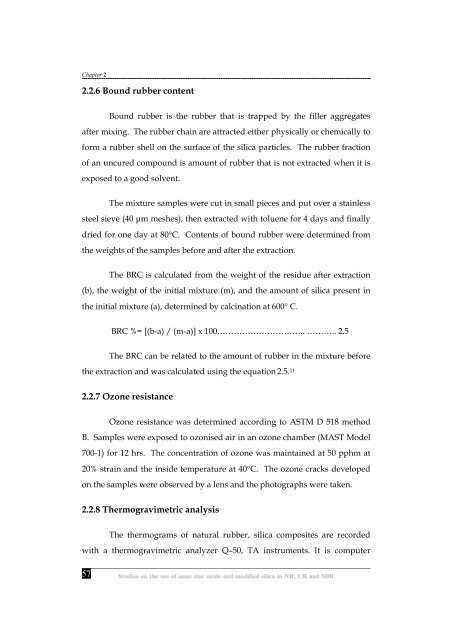Studies on the use of nano zinc oxide and modified silica in NR, CR ...
Studies on the use of nano zinc oxide and modified silica in NR, CR ...
Studies on the use of nano zinc oxide and modified silica in NR, CR ...
You also want an ePaper? Increase the reach of your titles
YUMPU automatically turns print PDFs into web optimized ePapers that Google loves.
Chapter 2<br />
2.2.6 Bound rubber c<strong>on</strong>tent<br />
57<br />
Bound rubber is <strong>the</strong> rubber that is trapped by <strong>the</strong> filler aggregates<br />
after mix<strong>in</strong>g. The rubber cha<strong>in</strong> are attracted ei<strong>the</strong>r physically or chemically to<br />
form a rubber shell <strong>on</strong> <strong>the</strong> surface <strong>of</strong> <strong>the</strong> <strong>silica</strong> particles. The rubber fracti<strong>on</strong><br />
<strong>of</strong> an uncured compound is amount <strong>of</strong> rubber that is not extracted when it is<br />
exposed to a good solvent.<br />
The mixture samples were cut <strong>in</strong> small pieces <strong>and</strong> put over a sta<strong>in</strong>less<br />
steel sieve (40 µm meshes), <strong>the</strong>n extracted with toluene for 4 days <strong>and</strong> f<strong>in</strong>ally<br />
dried for <strong>on</strong>e day at 80°C. C<strong>on</strong>tents <strong>of</strong> bound rubber were determ<strong>in</strong>ed from<br />
<strong>the</strong> weights <strong>of</strong> <strong>the</strong> samples before <strong>and</strong> after <strong>the</strong> extracti<strong>on</strong>.<br />
The BRC is calculated from <strong>the</strong> weight <strong>of</strong> <strong>the</strong> residue after extracti<strong>on</strong><br />
(b), <strong>the</strong> weight <strong>of</strong> <strong>the</strong> <strong>in</strong>itial mixture (m), <strong>and</strong> <strong>the</strong> amount <strong>of</strong> <strong>silica</strong> present <strong>in</strong><br />
<strong>the</strong> <strong>in</strong>itial mixture (a), determ<strong>in</strong>ed by calc<strong>in</strong>ati<strong>on</strong> at 600° C.<br />
BRC %= [(b-a) / (m-a)] x 100………………………….. ……….. 2.5<br />
The BRC can be related to <strong>the</strong> amount <strong>of</strong> rubber <strong>in</strong> <strong>the</strong> mixture before<br />
<strong>the</strong> extracti<strong>on</strong> <strong>and</strong> was calculated us<strong>in</strong>g <strong>the</strong> equati<strong>on</strong> 2.5. 11<br />
2.2.7 Oz<strong>on</strong>e resistance<br />
Oz<strong>on</strong>e resistance was determ<strong>in</strong>ed accord<strong>in</strong>g to ASTM D 518 method<br />
B. Samples were exposed to oz<strong>on</strong>ised air <strong>in</strong> an oz<strong>on</strong>e chamber (MAST Model<br />
700-1) for 12 hrs. The c<strong>on</strong>centrati<strong>on</strong> <strong>of</strong> oz<strong>on</strong>e was ma<strong>in</strong>ta<strong>in</strong>ed at 50 pphm at<br />
20% stra<strong>in</strong> <strong>and</strong> <strong>the</strong> <strong>in</strong>side temperature at 40°C. The oz<strong>on</strong>e cracks developed<br />
<strong>on</strong> <strong>the</strong> samples were observed by a lens <strong>and</strong> <strong>the</strong> photographs were taken.<br />
2.2.8 Thermogravimetric analysis<br />
The <strong>the</strong>rmograms <strong>of</strong> natural rubber, <strong>silica</strong> composites are recorded<br />
with a <strong>the</strong>rmogravimetric analyzer Q–50, TA <strong>in</strong>struments. It is computer

















